

When it comes to your baby's health and safety, every detail matters. Teething is a crucial milestone in your child's development, and the toys they use during this phase play a significant role. Ensuring that your baby's teething toys are clean and safe is of utmost importance to prevent potential health issues. In this comprehensive guide, we'll walk you through the essential steps to maintain teething toy hygiene, so your little one can explore the world while staying healthy.
Introduction
Teething can be a challenging time for both babies and parents. Babies often seek relief from sore gums by chewing on teething toys. However, these toys can quickly become breeding grounds for germs and bacteria if not properly maintained. In this article, we'll explore the significance of teething toy hygiene and provide you with practical tips to keep your baby's toys clean and safe.
Understanding the Importance of Teething Toy Hygiene
Teething toys are your baby's constant companions during this uncomfortable phase. Babies tend to put everything in their mouths, and teething toys are no exception. Ensuring their hygiene is essential to prevent the transmission of harmful pathogens and the development of oral health issues.
Types of Teething Toys
Before we delve into cleaning and safety measures, let's take a look at the various types of teething toys available:
- Silicone Teething Rings: Soft and easy to clean.
- Rubber Teething Toys: Durable but require regular cleaning.
- Plastic Teething Toys: Lightweight and often have textured surfaces.
- Fabric Teething Toys: Need extra attention to avoid mold growth.
Choosing Safe and Non-Toxic Materials of Teething Toys
When purchasing the best natural teethers, always opt for products made from safe and non-toxic materials. Check for labels or certifications that guarantee the absence of harmful chemicals like BPA, phthalates, and lead. Natural materials like organic cotton and untreated wood are excellent choices.
Cleaning Guidelines for Teething Toys
Maintaining a clean environment for your baby's teething toys is essential. Here are some cleaning guidelines to follow:
Daily Cleaning Routine
- Rinse teething toys with warm water after each use.
- Use a mild, baby-friendly soap for cleaning.
- Scrub gently with a baby toothbrush to remove residue.
- Rinse thoroughly and allow them to air dry.
Weekly Deep Cleaning
- Submerge teething toys in a mixture of warm water and white vinegar.
- Let them soak for 15-20 minutes.
- Scrub with a toothbrush to remove stubborn residue.
- Rinse thoroughly and air dry.
- Disinfecting Teething Toys
Periodically disinfecting teething toys is crucial, especially during flu seasons. Follow these steps:
- Create a solution of equal parts water and hydrogen peroxide.
- Immerse the toys and let them soak for 10 minutes.
- Rinse thoroughly and air dry.
Storage Tips for Teething Toys
Proper storage prevents contamination. Use a clean, dry container or bag to store teething toys when not in use. Avoid overcrowding, as it can hinder proper ventilation.
Recognizing Signs of a Dirty Toy
Knowing when a teething toy needs cleaning is essential. If you notice discoloration, an unpleasant odor, or visible residue, it's time for a thorough cleaning.
Alternatives to Traditional Teething Toys
Sometimes, traditional teething toys may not be the best option. Consider natural alternatives like a cold, damp washcloth, or frozen fruit in a mesh feeder.
Common Mistakes to Avoid
- Boiling Teething Toys: Boiling can damage some materials, so avoid it unless the manufacturer recommends it.
- Using Harsh Chemicals: Stick to baby-safe cleaning agents to prevent chemical exposure.
- Neglecting Textured Surfaces: Ensure you clean textured areas thoroughly.
Safety Precautions for Teething Toys
- Always supervise your baby while using teething toys.
- Check for wear and tear regularly and replace damaged toys.
- Keep small parts and choking hazards away from your child.
Conclusion
Maintaining proper hygiene for your baby's teething toys is paramount to ensuring their health and safety. As parents, we understand the importance of providing our little ones with the best care possible. Wristy Buddy’s teething toys offer a fantastic solution for both teething relief and easy cleaning.
By following the simple yet effective cleaning methods outlined in this blog, you can keep your baby's favorite teething companion in pristine condition. Regularly disinfecting these toys not only removes harmful germs but also prolongs their lifespan, making them a valuable investment for your child's teething journey.
Remember that a clean teething toy not only keeps your baby safe but also provides peace of mind for parents. With Wristy Buddy's commitment to quality and safety, you can trust that your baby's teething experience will be both enjoyable and secure.
So, as you embark on this exciting journey of parenthood, make teething toy hygiene a priority. Your baby's smile is worth it, and with Wristy Buddy, you're giving them the best start possible. Cheers to happy, healthy teething days!









